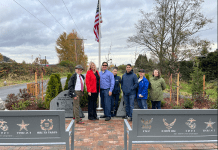Jini Dellaccio has almost always been compared to the famed, celebrity photographer Annie Leibowitz during her time behind the camera. The comparison mostly fits. The only difference is Dellaccio was first, by a full decade. Leibowitz might be great, but Dellaccio was a pioneer in the craft.
The late American photographer created some of the most iconic images of early rock and roll bands and artists. Her shutter recorded images of The Who, The Rolling Stones, Neil Young and The Beach Boys. She is particularly a part of Northwest rock-punk lore for her images of The Sonics, The Wailers and Merrilee Rush. You may not know of her, but you have enjoyed her style and photographic eye, particularly for her practice of shooting portraits outside of the controls of a studio. The Northwest pines, firs, mountains and waterways were her studio. Nature played a key element alongside the musicians themselves to show that the “Northwest sound” of the 1960s through the 1980s was as organic and genuine to the location as the bayou is to Louisiana jazz.

The fashion-turned-music portraitist went “minimal” when others went for the glitz, often shooting album covers and magazine portraits in and around her Gig Harbor home. Dellaccio’s signature included shoots of bands climbing trees, walking along the beach or eyeing Northwest architectural landmarks at the University of Washington and the greater Puget Sound.
Her largely unknown story is told in the 2013 film “Her Aim is Turn,” an award-winning documentary by British filmmaker Karen Whitehead that screened a year before her death at the age of 97. The movie not only recalls the storied tale that leads the Indiana-raised farm girl to rise to the peak of her profession after buying a used camera for $70 and teaching herself the craft of photography, but it brought her work to a new generation of fans. The film also focuses on the Northwest, following her move to Gig Harbor in 1961, after her husband Carl took a teaching job in Tacoma. Her fashion and travel images would appear on the walls of the Tacoma Art Museum a year later. Many of the local musicians from the early days of rock and roll as well as the grunge era that followed remark about her work throughout the film.

Far from the center of the fashion world of California, she branched into music photography, including in 1964 when the Tacoma-based Wailers wanted a new look for their upcoming album. They connected with Dellaccio, who created the cover for the best-selling “Wailers, Wailers, Everywhere.” Instead of a studio shoot, Dellaccio clicked her shutter of the band at Wright and Point Defiance parks. Her style was born.
“Of course, I knew exactly who she was from all those amazing photos of my favorite bands back in the 60s,” said Bon Von Wheelie, a drummer from the Tacoma-based Girl Trouble. “But meeting her was something else. She was one of those people that would light up the room just by coming through the door. She was such a positive force you could just see how she got those little punk teenagers to do whatever she wanted to get good photos.”

Keep in mind Dellaccio was often twice the age of her subjects because she was middle age when she picked up photography. She would go on to shoot the who’s who of music through the 1980s. She would take a break to care for her husband only to return to photography after his death in 2004.
Retrospectives of her work would appear on the walls of galleries and libraries that were rounded out with images from her shift to wildlife and nature photography. Thanks to the documentary film, her story and legacy will live on for future generations to admire.















































